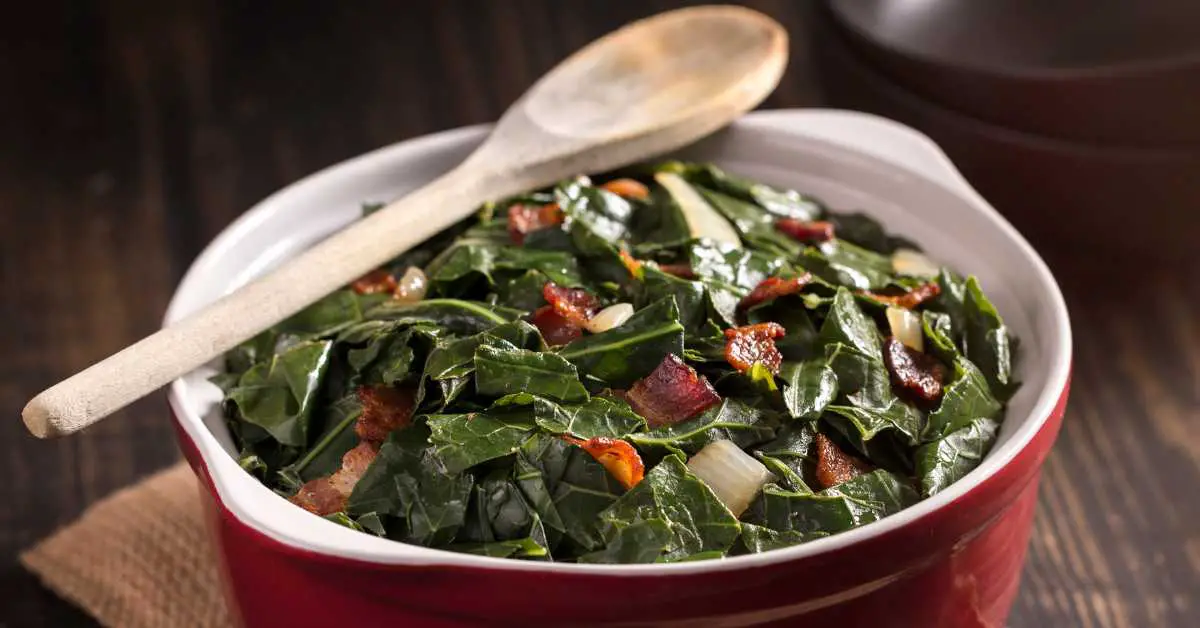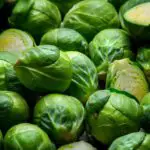Many Southern menus include the tasty collard greens and ham hocks recipe. This delicious side dish compliments a variety of meat and seafood dishes. It can also be used as an appetizer or small dish choice.
Collard greens are passed over as just another spinach side dish. However, these meaty and savory greens are an incredible addition to any meal. I’m also a fan of adding a dash or two of sriracha sauce to kick things up!
If you are not from the South, you may be wondering if collard greens and spinach are the same. While both are green and packed with nutrients, there are several differences that prevent them from being substitutes for each other in recipes.
Nutritional Facts
Spinach and collard greens are both high in dietary fiber. The amount of dietary fiber in collard greens is 82% greater than that of spinach, with spinach having 2.2 grams of fiber per 100 grams and collard greens having 4 grams per 100 grams.
The amount of protein in spinach and collard greens is similar – spinach contains 2.9g of protein per 100 grams and collard greens contain 3g.
Collard greens and spinach – What is the difference?
Spinach is a leafy vegetable from the Amaranthaceae family, whereas collard greens come from the Brassica oleracea species.
The leaves of collard greens are larger than those of spinach, and they taste more bitter as well.
Compared to other leafy greens, spinach has a smoother, more delicate texture. The fiber in collards is higher than that in spinach, but the minerals and vitamins in spinach are higher.
Do collard greens taste like spinach?
It’s not just their health benefits that make collard greens awesome, but also their delicious taste! Collard greens don’t have such an extremely bitter taste as kale and spinach. Instead, they taste more neutral which allows them to be used in a wide range of recipes.
Collards vs spinach – Which is healthier?
In addition to collard greens being more popular in southern states of the US, they are also extremely nutritious. Collard greens contain nearly twice the amount of calcium as spinach and are very high in potassium and magnesium, as well.
Is collard greens spinach?
No. Collard greens and spinach are both nutrient-dense leafy vegetables, but they are not the same thing. Collard greens have wide, dark green leaves and a more bitter flavor, and are typically cooked before being eaten due to their harder texture. On the other hand, spinach leaves are smaller, lighter in color, and milder in taste, and they can be eaten raw or cooked.
Do collard greens taste like spinach?
No. Collard greens and spinach do not taste the same. Collard greens have a harder texture and a more bitter flavor, requiring cooking to minimize these characteristics. Collard greens are often cooked with a ham hock or smoked turkey for a savory taste.
Spinach has a lighter, milder flavor that allows it to be enjoyed both raw or cooked.
What types of nutrients do collard greens contain?
The health benefits of collard greens include high levels of vitamins A, C, and K. These are important for healthy eyesight, a strong immune system, and heart health.
Collard greens are also a good source of calcium which is important for bone strength and preventing osteoporosis.
Finally, collard greens also contain magnesium which helps regulate the nervous system and keeps the muscles relaxed. It also contains high levels of iron which is necessary for transporting oxygen around the body to keep you feeling energized.
How do the vitamin contents of collard greens and spinach compare?
What are oxalates?
While both collard greens and spinach contain oxalates, a natural compound that binds with calcium and can potentially form kidney stones in some people.
Spinach generally has a higher oxalate content than collard greens. For those managing conditions like kidney stones where dietary oxalate needs to be restricted, it would be beneficial to consume collard greens over spinach.
Cooking can reduce the oxalate content in these vegetables, and incorporating a balanced diet is always essential for overall health.
High oxalate foods lists
Here’s a list of foods that are high in oxalates:
- Spinach
- Rhubarb
- Beets and beet greens
- Swiss chard
- Wheat bran
- Almonds
- Cashews
- Miso soup
- Soy products (tofu, soy milk)
- Okra
- Sweet potatoes
- Quinoa
- Chocolate
- Coffee
- Tea (black and green)
- Certain fruits such as figs, kiwi, and blackberries
- Buckwheat
- Navy beans
- Peanut butter
- Sesame seeds
Oxalate content can vary greatly depending on the specific type and processing method of the food. Consult with a healthcare provider or dietitian if you’re looking to limit oxalates in your diet.
What are the cooking methods for collard greens and spinach?
Collard greens and spinach both offer many health benefits, but they differ significantly in taste and texture.
Collard greens are often cooked for an extended time with other ingredients like onions, garlic, and various types of meat, which help to mellow their strong flavor.
Spinach has a milder, slightly sweet flavor and can be enjoyed raw in salads, briefly sautéed, or incorporated into various dishes like pasta and soups.

Claudia Faucher is a fitness trainer and lifestyle blogger, who recently started to pursue her other passions… Southern cooking and creating recipes.








1 thought on “Collard Greens vs Spinach”